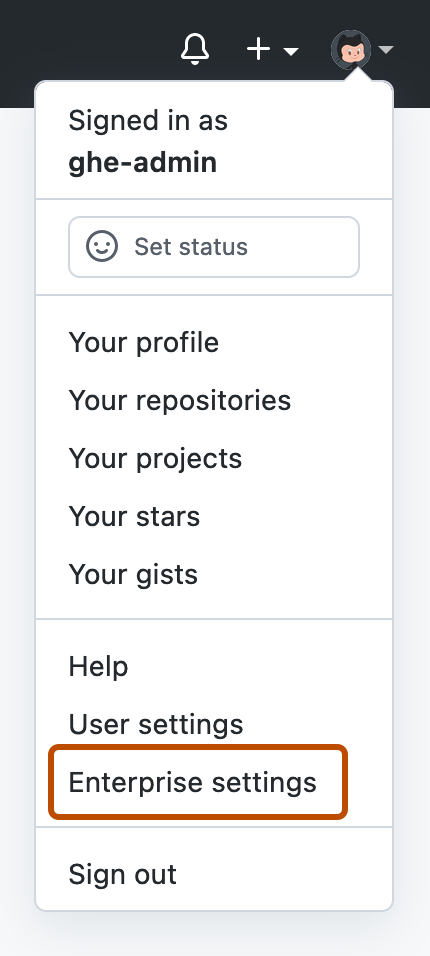关于企业中安全设置的策略
您可以在 上实施策略以控制企业拥有的组织的安全设置。 默认情况下,组织所有者可以管理安全设置。
要求企业中的组织进行双重身份验证
如果 你的 GitHub Enterprise Server 实例 使用 LDAP 或内置身份验证,则企业所有者可以要求企业拥有的所有组织中的组织成员、计费管理员和外部协作者使用双因素身份验证来保护其用户帐户。
必须为自己的帐户启用双重身份验证,然后才能对企业拥有的所有组织都要求双重身份验证。 有关详细信息,请参阅“使用双重身份验证 (2FA) 保护您的帐户”。
在您要求使用双重身份验证之前,我们建议通知组织成员、外部协作者和帐单管理员,并要求他们为帐户设置双重身份验证。 组织所有者可以查看成员和外部协作者是否已在每个组织的“People”页面上使用 2FA。 有关详细信息,请参阅“查看组织中的用户是否已启用 2FA”。
双因素身份验证代码的验证需要客户端设备和服务器上的准确时间。 站点管理员应确保时间同步已配置且准确无误。 有关详细信息,请参阅“配置时间同步”。
Warning
- 当你要求企业采用双重身份验证时,企业拥有的所有组织中未使用双重身份验证的外部协作者(包括机器人帐户)将从组织中移除,并失去对存储库的访问权限。 他们还会失去对组织私有仓库的复刻的访问权限。 如果他们在从你的组织中删除后的三个月内为其帐户启用双重身份验证,则可以恢复其访问特权和设置。 有关详细信息,请参阅“Reinstating a former member of your organization(恢复组织前成员的身份)”。
- 在你启用了必需的双重身份验证之后,企业拥有的任何组织中的任何外部协作者,如果其禁用了自己帐户的双重身份验证,都将自动从该组织中移除。 禁用双重身份验证的成员和账单管理员在重新启用双重身份验证前,将无法访问组织资源。
- 如果你是某个要求双重身份验证的企业的唯一所有者,则在不为企业禁用双重身份验证要求的情况下,你将无法为用户帐户禁用双重身份验证。
-
在 的右上角,单击你的个人资料照片,然后单击“企业设置”****。

-
在页面左侧的企业帐户边栏中,单击 “设置”。
-
在“ 设置”下,单击“身份验证安全性” 。
-
在“Two-factor authentication(双重身份验证)”下,审查有关更改设置的信息。 (可选)若要在更改设置之前查看企业帐户中所有组织的当前配置,请单击“ 查看组织的当前配置”。

-
在“Two-factor authentication”下,选择“Require two-factor authentication for the enterprise and all of its organizations”,然后单击“Save”********。
-
如果出现提示,请阅读有关双重身份验证要求将如何影响用户对组织资源的访问的相关信息。 若要确认更改,请单击“Confirm”****。
-
(可选)如果从您的企业拥有的组织中删除了任何外部协作者,我们建议向他们发送邀请,以恢复其以前对组织的权限和访问权限。 每个人都必须启用 2FA,然后才能接受你的邀请。
管理企业的 SSH 认证机构
您可以使用 SSH 认证机构 (CA) 来允许企业拥有的任何组织的成员使用您提供的 SSH 证书访问该组织的存储库。 Enterprise 成员也可以允许使用证书访问个人拥有的仓库。 您可以要求成员使用 SSH 证书访问组织资源,除非 SSH 已在仓库中禁用。 有关详细信息,请参阅“关于 SSH 认证中心”。
在颁发每个客户端证书时,必须包含扩展,以指定证书用于哪个 GitHub 用户。 有关详细信息,请参阅“关于 SSH 认证中心”。
添加 SSH 认证中心
如果您的企业需要 SSH 证书,企业成员应使用特殊的 URL 通过 SSH 进行 Git 操作。 有关详细信息,请参阅“关于 SSH 认证中心”。
每个证书颁发机构只能上传到 GitHub 上的一个帐户。 如果 SSH 证书颁发机构已添加到某个组织或企业帐户,则不能将该证书颁发机构添加到 GitHub 上的其他组织或企业帐户。
如果将一个证书颁发机构添加到企业中,并将另一个证书颁发机构添加到企业组织中,则任一证书颁发机构都可用于访问组织的存储库。
-
在 的右上角,单击你的个人资料照片,然后单击“企业设置”****。

-
在页面左侧的企业帐户边栏中,单击 “设置”。
-
在“ 设置”下,单击“身份验证安全性” 。
-
在“SSH 证书颁发机构”右侧,单击“新建 CA”。
-
在“Key(密钥)”下,粘贴您的公共 SSH 密钥。
-
单击“添加 CA”。
-
(可选)若要要求成员使用 SSH 证书,请选择“需要 SSH 证书”,然后单击“保存” 。
Note
当需要 SSH 证书时,用户将无法通过 HTTPS 或通过无符号的 SSH 密钥 .
该要求不适用于获得授权的 GitHub Apps(包括用户到服务器的令牌)、部署密钥或 GitHub 功能,例如 GitHub Actions,它们是 GitHub 生态系统中的受信任环境。
管理对用户所有的存储库的访问
如果企业使用 托管用户帐户,则你可以启用或禁用访问包含 SSH 证书。
-
在 的右上角,单击你的个人资料照片,然后单击“企业设置”****。

-
在页面左侧的企业帐户边栏中,单击 “设置”。
-
在“ 设置”下,单击“身份验证安全性” 。
-
在“SSH 证书颁发机构”下,选中“访问用户拥有的存储库”复选框。
删除 SSH 认证中心
对 CA 的删除无法撤销。 如果以后要使用同一 CA,您需要重新上传该 CA。
-
在 的右上角,单击你的个人资料照片,然后单击“企业设置”****。

-
在页面左侧的企业帐户边栏中,单击 “设置”。
-
在“ 设置”下,单击“身份验证安全性” 。
-
在“SSH 证书颁发机构”下,在要删除的 CA 右侧,单击“删除”。
-
阅读警告,然后单击“我了解,请删除此 CA”。
升级 SSH 认证中心
在 2024 年 3 月 27 日之前上传到企业 GitHub Enterprise Server之前,版本 3.13 允许使用未过期的证书。 若要详细了解现在新的 CA 需要过期的原因,请参阅“关于 SSH 认证中心”。 你可以升级现有 CA,以防止它发布未过期的证书。 为了获得最佳安全性,我们强烈建议你在验证不依赖于未过期证书后升级所有 CA。
-
在 的右上角,单击你的个人资料照片,然后单击“企业设置”****。

-
在页面左侧的企业帐户边栏中,单击 “设置”。
-
在“ 设置”下,单击“身份验证安全性” 。
-
在“SSH 证书颁发机构”下,在要升级的 CA 右侧,单击“升级”****。
-
阅读警告,然后单击“升级”****。
升级 CA 后,该 CA 签署的非过期证书将被拒绝。